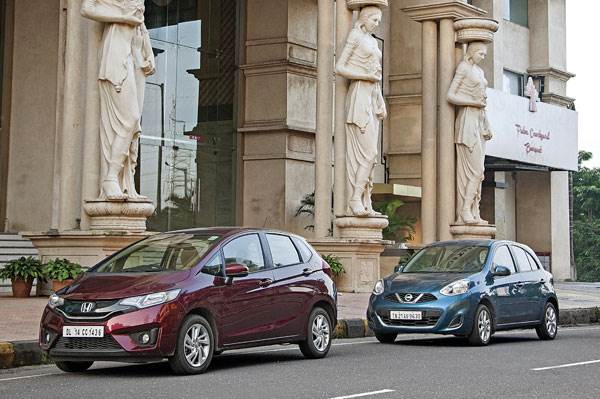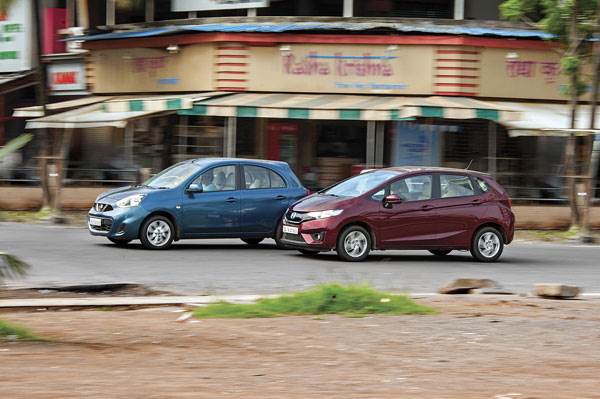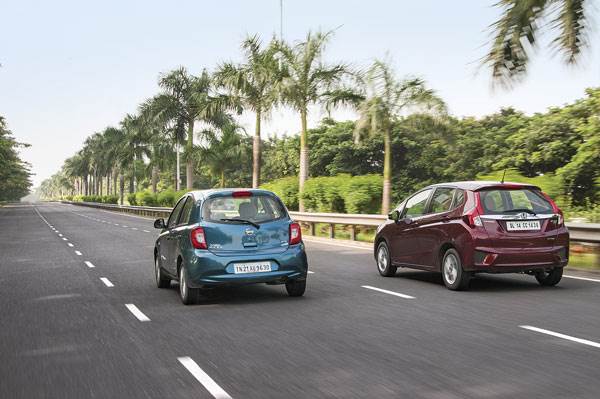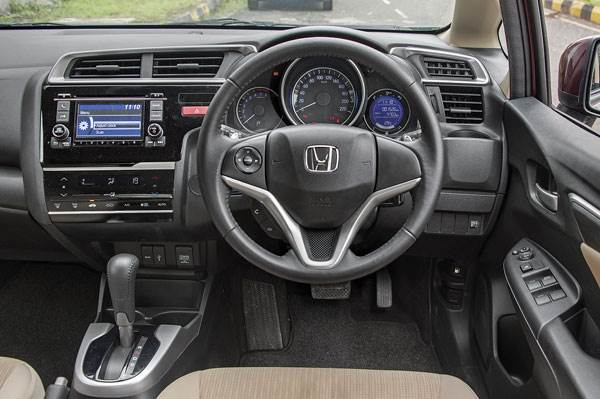The case for automatic hatchbacks hardly needs strengthening these days. A steady increase in the number of cars on our streets, the poor infrastructure that can hardly accommodate these kind of numbers and the improved fuel efficiency of modern autos when compared to older examples, are more than sufficient reasons to get yourself a two-pedal car that’s relatively diminutive and hence easy to manoeuvre. The newest arrival to this fold is the second-generation Honda Jazz. It’s the Japanese carmaker’s second coming with this model in our market, and they’ve made sure they’ve got it right this time. This premium hatchback is now packed with features, and apart from the diesel engine, Honda has covered its bases with a CVT automatic for the petrol too, giving it an edge over its main rival, the manual-only Hyundai i20. So then, what does it have in terms of competition? Well, the closest is another Japanese offering in the segment – the Nissan Micra, which also uses a CVT. The Micra has been here for some time but got a facelift in 2013 that ditched its cutesy rounded looks. So, which of these premium hatchbacks should you opt for?
On the surface
The new Jazz doesn’t look too different from the last model and it retains the sleek, space-aged silhouette that was always ahead of its time. There’s plenty of new touches though – like the chrome strip on the multi-element grille and on the boot, the ridges that run along the sides, the 3D-effect tail-lamps and the swooping roofline – and they all add up nicely. What does look odd though, are the small, 14-inch wheels and narrow tyres, especially against the Jazz’s large-for-a-hatchback dimensions.

The Micra, on the other hand, is visibly smaller. It’s no longer as cute and rounded as it used to be before 2013’s facelift, but it’s still less angular and sporty looking than the Honda. The aggressive chin and the big grille with the trademark chrome bar look nice, but won’t turn any heads like the Honda would.

Estate affairs
Open the doors and the Jazz astonishes you with the kind of room on offer. You know it’s a spacious car when you look at it from outside, but what it doesn’t reveal is Honda’s excellent packaging skills. The front seats are comfortable, be it in terms of space or the cushioning and bolstering – it’s a great place to be in even over long distances. The large glasshouse allows for a decent view out and what’s especially nice is the front quarter windows that help the view ahead when going around corners. Both cars get rake adjustable steering wheels and this makes finding a comfortable driving position easy. Move to the back and the space is amazing for a hatchback. The seats themselves are comfortable, except for the short seat squab, which is a little down on thigh support. The 354-litre boot is good for a couple of big bags, par for course for a city-friendly car.

The Micra doesn’t offer as much real estate inside as the Honda, but it’s still pretty decent. While you do sit a lot closer to co-passengers and may not have as much space to stretch out, you’re not exactly hemmed in either. The seats, both front and rear, are quite comfy, if with a slightly firmer cushioning than the Honda. The view out from the front seat is quite decent too and makes it easy to judge the extremities of the car in tight traffic. In the rear, while it doesn’t have as much leg-, knee- or headroom as the Jazz, the Micra ◊ ∆ does have adjustable headrests. As trivial as that sounds, these play a vital role in protecting rear seat occupants from whiplash. Also, Nissan has provided slightly longer seat squabs, thereby improving under-thigh support and comfort over long distances. It’s not as easy to squeeze in three abreast here as in the Jazz. Once you open up that hatch at the back, you’ll realise that the boot can only hold just about enough luggage for a small trip. But these are meant to be city cars, and you’re hardly going to be taking either of these for a cross-country trek.

Lay and feel
Right from when you slip in behind the wheel, the Jazz feels premium. The dashboard is uncluttered – the 5-inch screen taking pride of place – the material quality is good and contrasting colours look nice, although the faux-aluminium bits do seem a little down on the plush-feeling parts. Buttons are aplenty, but they’re laid out in a coherent manner. The screen also doubles up as a display for the rear camera, something the Nissan misses out on entirely. What looks particularly premium is the touch controls for the air-conditioning. Unfortunately, operating it on the go is not particularly easy. There are also plenty of storage spaces to stow away your knick-knacks. The centre console gets an entire assemblage of cubbyholes, there are bottle holders in each door and particularly handy is the cupholder to the right of the steering – ideal for holding your coffee or soda at an easy-to-reach place.

The Micra’s dash, while it does get a glossy back for the infotainment system, misses out on a big, modern-looking screen like in the Honda. Also, the buttons are placed in a circular pattern, which feels a bit gimmicky and takes a little getting used to. The levels of material quality, though, are not nearly as good enough as the Honda’s and dull plastics dominate the proceedings. Even in terms of storage space, the Jazz packs in more.

Performance
The Jazz gets Honda’s 88.5bhp 1.2-litre iVTEC petrol motor under the hood and it’s a refined, smooth unit. The CVT gearbox it’s mated to works well enough, albeit with the inherent weakness of this type of automatic. The motor takes a bit of time to wake up from lower revs and this, combined with the CVT rubberband effect, could be an irritant in start-stop traffic situations. But if you gently accelerate, this problem could ◊ ∆ be worked around. Honda does offer different driving modes – D and S. Switching modes allows you to hold on to gears for longer, but even in S, the ’box upshifts at 6000rpm. Not that it provides too much of a variance in experience; in fact, the motor starts to sound strained as the revs build.

And noise is an issue with the Micra’s 1.2-litre three-cylinder petrol engine. It feels a lot less refined than the Honda unit and more so when you’re piling on the throttle. That said, the engine does start off more eagerly than the Jazz’s and that should work a lot better in city traffic. The Nissan’s CVT auto ’box provides different driving modes as well, and here, there is quite a perceptible change. But that only goes to highlight the already pronounced CVT-typical response in Normal mode. The Micra’s Sport mode is immensely better and you may be better off using this throughout unless it’s fuel economy you’re concerned about.

Ride and handling
The Jazz is quite fun to drive for something its size, although the skinny rubber can be felt when you’re pushing it hard around corners. But it is nimble in a bend owing to the sharp and responsive steering. The ride is slightly stiff, but the Honda handles most of our roads with decent composure.
Over the same potholes, the Micra does hold its own, but can’t match the Jazz. The suspension, though a little softer, isn’t as comfortable as the Honda’s; it also sounds noisier. Though stability at high speeds is good, you do feel a bit of up-and-down movement over undulations. As for changing direction, the steering requires more effort and feels vague as well, not making the driving experience too engaging.

Verdict
The Nissan Micra is a capable city car in its own right. It looks nice, can be manoeuvred easily through tight spaces, is easy to drive in traffic and is pretty comfortable. At Rs 85,000 less, this top-of-the-line XV version would appear to make more sense for your wallet as well. But in all these spheres where it manages an average or good ranking, the Jazz takes the game well ahead. It is relatively on the pricey side, but it does offer quite a bit for the premium. It looks stylish, is comfortable and well equipped. More importantly, for someone looking at this segment, it offers tonnes of space and practicality. Add to that, it’s fun to drive too. The Jazz is the clear winner here, and given that the competition does hold its own rather well, it only goes to show how much of an accomplishment this new Honda is, even at a premium.






Comments
Member Login
Personal Details
No comments yet. Be the first to comment.